 |
 |
 |
| |
Reanalysis of the MERIT Study with the Enhanced Trofile Assay (MERIT-ES)
|
| |
| |
Reported by Jules Levin
48th Annual ICAAC/IDSA 46th Annual Meeting, Washington, DC, USA, October 25-28, 2008
M Saag1, J Heera2, J Goodrich2, E DeJesus3, N Clumeck4, D Cooper5, S Walmsley6, N Ting2, E Coakley7, J Reeves7, M Westby8 E van der Ryst8 and H Mayer2
1Univ. of Alabama at Birmingham, Birmingham, AL, USA; 2Pfizer Global Rearch and Development, New London, CT, USA; 3Orlando Immunology Ctr., Orlando, FL, USA; 4Saint-Pierre Univ. Hosp., Brussels, Belgium; 5Univ. of New South Wales, Sydney, Australia; 6Univ. of Toronto, Toronto, Canada; 7Monogram BioSci.s, South San Francisco, CA,
USA; 8Pfizer Global Research and Development, Sandwich, UK
For further information, please contact Michael Saag at msaag@uab.edu
AUTHOR DISCUSSION and CONCLUSIONS
This reanalysis examined the hypothesis that an assay with increased sensitivity for detection of CXCR4-using virus would identify and exclude more patients unlikely to respond to maraviroc with an improvement in efficacy overall.
The original trofile assay is no longer available; therefore this analysis, while retrospective, was critical to inform appropriate clinical practice.
The enhanced Trofile assay reclassified approximately 15% of patients as non R5 HIV and identified approximately 52% of patients who had DM virus at baseline or on study.
Reclassification with the enhanced Trofile assay resulted in fewer overall discontinuations and discontinuations due to lack of efficacy in the maraviroc arm but had little impact on these outcomes in the efavirenz arm.
The lower bound of the one-sided 97.5% CI for the 48-week treatment difference between MVC and EFV, for both the <400 and <50 copies/mL endpoint, was above -10% in this retrospective analysis.
As this is a retrospective analysis, the confidence intervals presented in this poster are for descriptive purposes only.
BACKGROUND
The MERIT study is an ongoing, randomized, double-blind study designed to compare the safety and efficacy of maraviroc (MVC) 300 mg BID vs efavirenz (EFV) 600 mg QD, both administered with a fixeddose combination of zidovudine and lamivudine (Combivir, CBV), in treatment-naive patients with R5 HIV-1 (Trofile assay, Monogram Biosciences, South San Francisco, CA) (Figure 1).
As previously presented,1 analysis of Week-48 data did not show noninferiority of MVC vs EFV for <50 copies/mL at Week 48 (ITT).
65% of patients receiving MVC + CBV achieved an HIV-1 RNA level of <50 copies/mL compared to 69% for EFV + CBV.
More patients discontinued from MVC + CBV for lack of efficacy compared to EFV + CBV (11.9% vs 4.2%), whereas fewer patients discontinued MVC + CBV due to adverse events (4.2% vs 13.6%).1
A total of 58 patients in the MVC and EFV arms discontinued due to lack of efficacy in the original Week 48 analysis.2
19/43 patients who failed due to lack efficacy in the MVC arm had DM/X4 at failure2 but none in the efavirenz arm.
The enhanced Trofile assay (recently launched by Monogram Biosciences) has replaced the original Trofile assay and has significantly improved ability to detect CXCR4-using minor variants in a mixed HIV population.3,4
There is a 30-fold increase in sensitivity for detection of minority variants between the original Trofile and the enhanced Trofile assay.
Only the enhanced Trofile assay is used in clinical practice today.
The rationale for conducting this analysis is that this enhanced sensitivity assay would identify a population of patients with a decreased likelihood of treatment failure associated with emergence of CXCR4-using HIV-1.
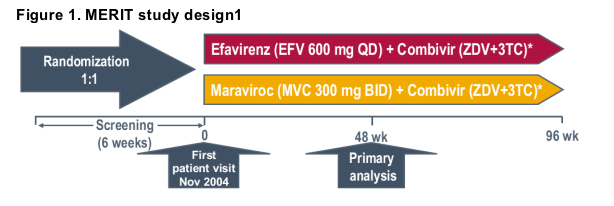
Patient Eligibility Criteria
· 16 years of age
· Treatment naive
· R5 HIV-1 infection
· HIV-1 RNA 2,000 copies/mL
· No evidence of resistance to EFV, ZDV, or 3TC
Patients Stratified by
· HIV-1 RNA < and 100,000 copies/mL at screening
· Geographic location: Northern Hemisphere and Southern Hemisphere
*Patients experiencing toxicity to ZDV or 3TC were permitted to substitute an alternative NRTI
METHODS
· The screening samples from MERIT patients enrolled on the basis of an R5 Trofile result were retested with the enhanced Trofile assay.
· The Monogram Biosciences' Clinical Reference Laboratory performed the enhanced Trofile assay using stored env expression vector pools from all 721 patients who had an R5 tropism result by the original Trofile assay.
· No clinical outcome information from the MERIT study was available to Monogram Biosciences.
· All analyses were prespecified by Pfizer in a statistical analysis plan.
RESULTS
Overall, 106/721 (15%) of patients who had an R5 tropism result at screening with the original Trofile assay were classified as non-R5 when screening samples were reanalyzed with the enhanced Trofile assay (Table 1). All had a D/M tropism result.
One patient, who had been randomized in error, had a non-R5 tropism result with the original Trofile assay at screening.
Reanalysis with the enhanced Trofile at screening identified 52% of patients who displayed D/M HIV-1 at baseline or on study and only 12% of those who displayed R5 at baseline or on study (Table 2).
The proportion of patients with discordant original Trofile vs enhanced Trofile screening results was similar between the MVC and EFV arms.
Removing the 107 patients whose virus was classified as D/M by the enhanced Trofile assay from the analysis population did not alter the balance of demographics and baseline characteristics (Table 3).
Figures 2a and 2b compare the virologic responses over time, in the original Trofile population analyses (MERIT)1 and the enhanced Trofile population (MERIT-ES).
In the original analysis, 69% of patients receiving EFV + CBV achieved HIV-1 RNA <50 copies/mL at Week 48, compared with 64% of patients receiving MVC + CBV1 (Figure 2b).
In the enhanced Trofile analysis, 68% of patients achieved HIV-1 RNA <50 copies/mL at Week 48 in both the EFV + CBV arm and the MVC + CBV arm (Figure 2b). Analysis of virologic response at Week 48 is shown in Figure 3.
Improved virologic responses in the enhanced Trofile population were seen with MVC in those with high baseline viral load as well as those with low baseline viral load (Figure 4).
In both analyses (MERIT and MERIT-ES), patients receiving MVC demonstrated greater increases from baseline in CD4+ cell count relative to EFV (Figure 5).
On reanalysis with enhanced Trofile, the total overall discontinuations on MVC decreased from 97 (27%) to 76 (24%) patients, while the number of discontinuations due to lack of efficacy decreased from 43 (12%) to 29 (9%) patients (Table 4). The reanalysis had little effect on numbers of patients discontinuing in the EFV arm.
Discontinuations due to adverse events remained higher in the EFV arm than in the MVC arm (Table 4).
Key adverse events leading to discontinuation are detailed in Table 5.
No safety signal emerged from this reanalysis, as expected given that the reanalysis population is a subset of a larger population.
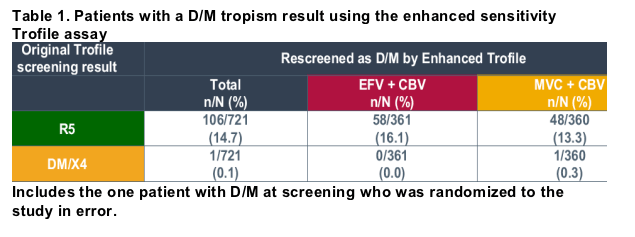
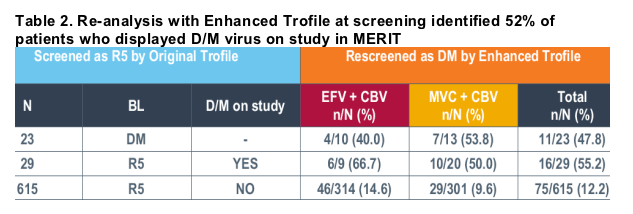
Subjects with a D/M HIV-1 tropism result or who had a non-reportable result at screening are not included. Subjects with a R5 HIV-1 tropism result at screening and baseline but without post-baseline records are not included. Subjects with a R5 HIV-1 tropism result at screening and baseline with at least one post-baseline D/M result are included in Row 2. Remaining subjects with post baseline results are included in Row 3. This table does not include the one patient with D/M at screening who was randomized to the study in error.
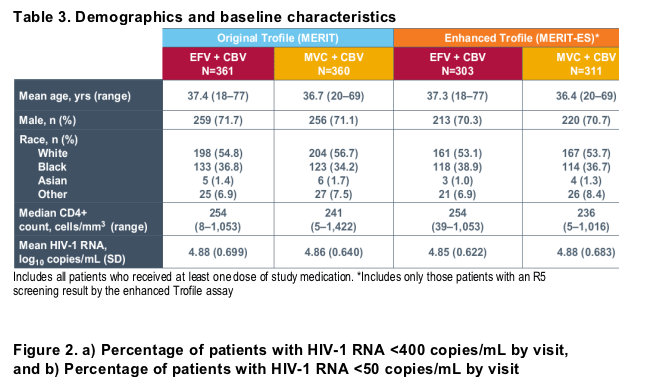
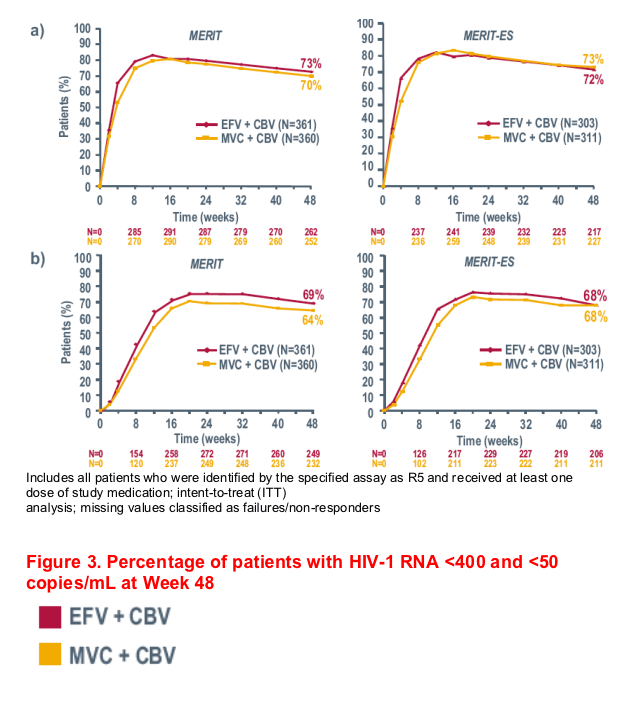
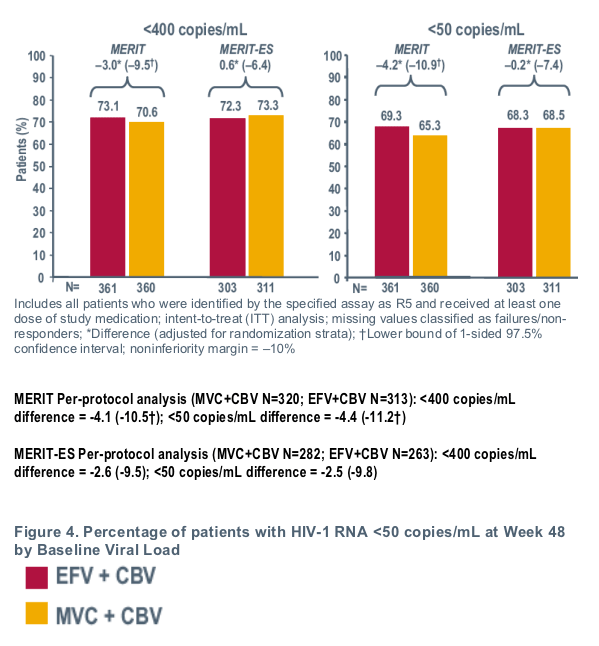
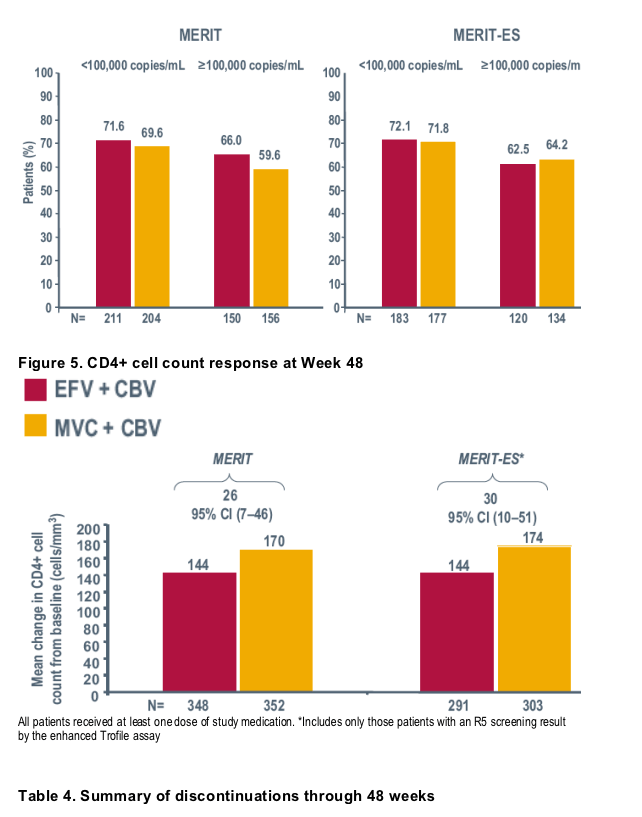
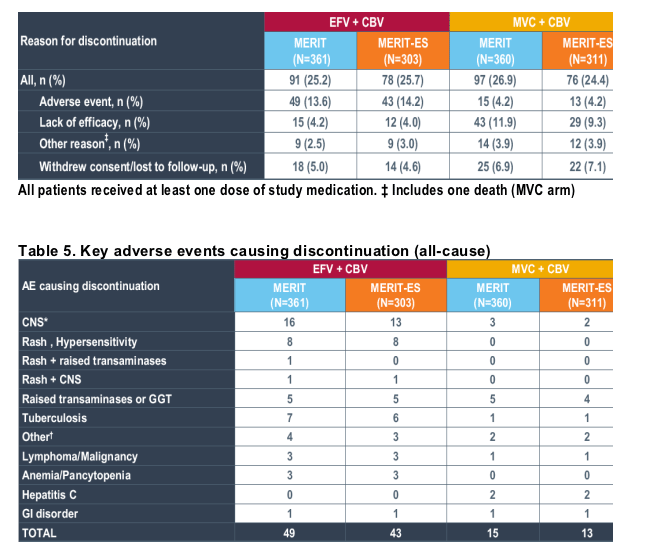
*Anxiety +/- panic attacks, insomnia, sleep disorder, suicidal ideation/attempt, major depression, headache, nightmare, dizziness, hangover/sluggishness/emotional distress, confusion, restlessness, disturbed attention, somnolence, double vision, vertigo, abnormal dreams, hallucinations.EFV - gynecomastia, myocardial infarction, renal failure, relapse substance abuse; MVC - myositis, syncope. In any individual , other adverse events may have occurred together with the key adverse events listed
REFERENCES
1. Saag M, et al. 4th IAS. Sydney, Australia, July 22-25, 2007; Abstract WESS104
2. Heera J, et al. 15th CROI. Boston, USA, February 3-6, 2008; Abstract 40LB
3. Trofile co-receptor tropism enhanced sensitivity assay protocol. Available at: www.trofileassay.com
4. Trinh L, et al. XVII HIV Drug Resistance Workshop. Sitges, Spain, June 10-14, 2008; Abstract 88
|
| |
|
 |
 |
|
|